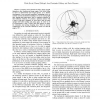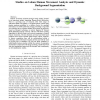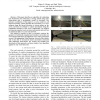IROS
2009
IEEE
14 years 6 months ago
2009
IEEE
— In nature, many animals are able to jump, upright themselves after landing and jump again. This allows them to move in unstructured and rough terrain. As a further development ...
IROS
2009
IEEE
14 years 6 months ago
2009
IEEE
IROS
2009
IEEE
14 years 6 months ago
2009
IEEE
—This paper presents a novel appearance-based technique for qualitative spatial localization. A vocabulary of visual words is built automatically, representing local features tha...
IROS
2009
IEEE
14 years 6 months ago
2009
IEEE
— When children learn to grasp a new object, they often know several possible grasping points from observing a parent’s demonstration and subsequently learn better grasps by tr...
IROS
2009
IEEE
14 years 6 months ago
2009
IEEE
— In this paper, we introduce a high-speed vision platform, H3 (Hiroshima Hyper Human) Vision, which can simultaneously process a 1024× 1024 pixel image at 1000 fps and a 256× ...
IROS
2009
IEEE
14 years 6 months ago
2009
IEEE
Abstract— This paper presents a novel method for sensorbased exploration of unknown environments by a general robotic system equipped with multiple sensors. The method is based o...
IROS
2009
IEEE
14 years 6 months ago
2009
IEEE
— We present an approach to navigating a biped robot safely and efficiently through a complicated environment of previously unknown obstacles and terrain using only onboard sens...
IROS
2009
IEEE
2009
IEEE
Human Robot interaction studies on laban human movement analysis and dynamic background segmentation
14 years 6 months ago
— Human movement analysis through vision sensing systems is an important subject regarding Human-Robot interaction. This is a growing area of research, with wide range of aplicat...
IROS
2009
IEEE
14 years 6 months ago
2009
IEEE
— This paper describes an algorithm for estimating lane boundaries and curbs from a moving vehicle using noisy observations and a probabilistic model of curvature. The primary co...
IROS
2009
IEEE
14 years 6 months ago
2009
IEEE
Abstract— Autonomous estimation of the altitude of an Unmanned Aerial Vehicle (UAV) is extremely important when dealing with flight maneuvers like landing, steady flight, etc. ...



